Overview
- Brief Narrative
- Allied military currency valued at 10 marks acquired by Dixie Foster when she worked as as a civilian court reporter during the US War Crimes Tribunal at the former Dachau concentration camp in Germany, also known as the Dachau war crimes trials. The trials were conducted in the American postwar occupation zone by the US Army from November 1945 to August 1948. It was inscribed on May 5, 1946, by Dixie and a US Colonel with whom she worked in Germany.
- Date
-
issue:
approximately 1944 September 08
received: approximately 1946 May
- Geography
-
issue:
Germany
- Credit Line
- United States Holocaust Memorial Museum Collection, Gift of Gretchen Davenport
- Markings
- face, upper center : ALLIIERTE MILITÄRBEHÖRDE [ALLIED MILITARY AUTHORITY]
face, near each corner, blue ink : 10
face, upper left and lower right, blue ink : SERIE 1944 [SERIES 1944]
face, center, blue ink : IN / UMLAUF GESETZT / IN DEUTSCHLAND / ZEHN MARK [IN / CIRCULATION / SET / IN GERMANY / TEN MARK]
face, right : M
face, serial number, lower center, black ink : -87134804
back, upper center : ALLIIERTE MILITÄRBEHÖRDE [ALLIED MILITARY AUTHORITY] - Contributor
-
Subject:
Dixie Foster
Issuer: Allied Forces
- Biography
-
Dixie Foster was born on September 6, 1912, in Cedar City, Utah, to Solon and Emma Morris Foster. Her father was a bank cashier and she had five siblings. Dixie’s mother passed away on February 20, 1920, and her father remarried that year to Helen Nelson, originally from Sweden. Dixie attended Branch Agricultural College in Cedar City. In 1940, Dixie worked as a court reporter for the Public Service Commission in Salt Lake City.
The United States entered World War II on December 8, 1941, and declared war on Nazi Germany on December 11. On May 7, 1945, Germany surrendered to the Allies, ending the war in Europe. The 1943 Moscow Declaration had determined that those responsible for war crimes would be tried for those crimes after the war. In addition to the trials of major war criminals by the International Military Tribunal at Nuremberg, the Allies held trials in their zones of occupation. A US Military Tribunal was held at the site of the former Dachau concentration camp in Germany to try concentration camp guards and other persons who had committed crimes against Jews and others in the area. The evidence and eyewitness testimonies presented at these trials brought to view the extent of the Nazi concentration camp system. Dixie obtained a position as a civilian court reporter for the US Military Tribunal known as the Dachau war crimes trials. She was present at the following judicial proceedings: a US prisoner of war trial, US v. Heinrich Birnbreier et al, on April 21-25, 1947, a Mauthausen-Gusen camp trial, US v. Karl Glas et al, on August 11-12, a Dachau camp trial, US v. Johannes Berscheid et al, on August 21-25, and a Mauthausen-Gusen trial, US v. Karl Moegle, on September 8-9. Dixie returned to the United States in January 1948. The Dachau Trials adjourned in August 1948. Dixie passed away on April 4, 1998, at the age of 85, in Utah.
Physical Details
- Classification
-
Exchange Media
- Category
-
Money
- Object Type
-
Military currency (lcsh)
- Physical Description
- Rectangular, offwhite paper currency. The face has a graphic design in black ink on a blue floral background. On the right is a medallion with the letter M; above and below is the numeric denomination 10. On the left is scrollwork bordering the denomination 10; above is the denomination 10 within an oval. In the upper and lower right corners are an acanthus leaf and scrolls. On the upper border and on the center is German text; the serial number in black ink is near the center. The back has a graphic design in light brown ink with scrollwork near the corners. In the center is a large medallion with the letter M surrounded by scrolls and acanthus leaves. On the upper center is German text; on the right and lower border is handwritten text in black ink.
- Dimensions
- overall: Height: 2.750 inches (6.985 cm) | Width: 4.375 inches (11.113 cm)
- Materials
- overall : paper, ink
- Inscription
- back, right, vertically, black ink : Bus Ke[illegible]y / Col US Army / Y. B[illegible] / [illegible] / Lt Col US Army
back, lower border, upside down, black ink : Dixie Fosters’ sh[illegible] - 5 May 1946
Rights & Restrictions
- Conditions on Access
- No restrictions on access
- Conditions on Use
- No restrictions on use
Keywords & Subjects
Administrative Notes
- Legal Status
- Permanent Collection
- Provenance
- The paper currency was donated to the United States Holocaust Memorial Museum in 2004 by Gretchen Davenport, the great-niece of Dixie Foster.
- Funding Note
- The cataloging of this artifact has been supported by a grant from the Conference on Jewish Material Claims Against Germany.
- Record last modified:
- 2023-08-23 15:30:57
- This page:
- https://collections.ushmm.org/search/catalog/irn521971
Download & Licensing
In-Person Research
- By Appointment
- Request 21 Days in Advance of Visit
- Plan a Research Visit
- Request to See This Object
Contact Us
Also in Dixie Foster collection
The collection consists of currency, documents, publications, and a scrapbook relating to the experiences of Dixie Foster when she worked as a court reporter during the US Military Tribunal known as the Dachau war crimes trials, in Germany after World War II.
Date: 1939-1947
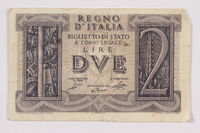
Kingdom of Italy, 2 lire note, acquired by a war crimes trials court reporter
Object
Italian 2 lire bank note acquired by Dixie Foster when she worked as a civilian court reporter during the US War Crimes Tribunal at the former Dachau concentration camp in Germany, also known as the Dachau war crimes trials. The trials were conducted in the American postwar occupation zone by the US Army from November 1945 to August 1948. The Kingdom of Italy had a Fascist government from 1922-1943, led by Benito Mussolini. It was closely allied with Nazi Germany and lost control of most of the country in 1943. Not long after the war ended on May 7, 1945, a constitutional referendum was held in June 1946 and Italy abolished the monarchy and became a republic.
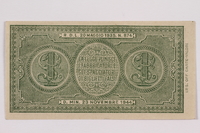
Italy Ministry of the Treasury, 1 lire note, acquired by a war crimes trials court reporter
Object
Italian 1 lire bank note acquired by Dixie Foster when she worked as a civilian court reporter during the US War Crimes Tribunal at the former Dachau concentration camp in Germany, also known as the Dachau war crimes trials. The trials were conducted in the American postwar occupation zone by the US Army from November 1945 to August 1948. The Kingdom of Italy had a Fascist government from 1922-1943, led by Benito Mussolini. It was closely allied with Nazi Germany and lost control of most of the country in 1943. This currency was issued in 1944 by the provisional government established with Allied support in the non-Fascist region. Not long after the war ended on May 7, 1945, a constitutional referendum was held in June 1946 and Italy abolished the monarchy and became a republic.
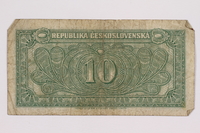
Republic of Czechoslovakia, 10 korun note, acquired by a war crimes trials court reporter
Object
Czechoslovakian 10 korun bank note acquired by Dixie Foster when she worked as a civilian court reporter during the US War Crimes Tribunal at the former Dachau concentration camp in Germany, also known as the Dachau war crimes trials. The trials were conducted in the American postwar occupation zone by the US Army from November 1945 to August 1948. During World War II, Czechoslovakia ceased to exist as the country was partitioned and absorbed by Nazi Germany and its allies. In April 1945, Germany was losing the war and the Third Republic of Czechoslovakia was created. This currency was issued on November 1, 1945, by the new republic.
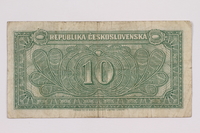
Republic of Czechoslovakia, 10 korun note, acquired by a war crimes trials court reporter
Object
Czechoslovakian 10 korun bank note acquired by Dixie Foster when she worked as a civilian court reporter during the US War Crimes Tribunal at the former Dachau concentration camp in Germany, also known as the Dachau war crimes trials. The trials were conducted in the American postwar occupation zone by the US Army from November 1945 to August 1948. During World War II, Czechoslovakia ceased to exist as the country was partitioned and absorbed by Nazi Germany and its allies. In April 1945, Germany was losing the war and the Third Republic of Czechoslovakia was created. This currency was issued on November 1, 1945, by the new republic.
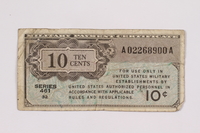
United States Military payment certificate, 10 cent note, acquired by a war crimes trials court reporter
Object
Military payment certificate for 10 cents acquired by Dixie Foster when she worked as a civilian court reporter during the US War Crimes Tribunal at the former Dachau concentration camp in Germany, also known as the Dachau war crimes trials. The trials were conducted in the American postwar occupation zone by the US Army from November 1945 to August 1948.
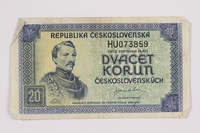
Republic of Czechoslovakia, 20 korun note, acquired by a war crimes trials court reporter
Object
Czechoslovakian 20 korun bank note acquired by Dixie Foster when she worked as a civilian court reporter during the US War Crimes Tribunal at the former Dachau concentration camp in Germany, also known as the Dachau war crimes trials. The trials were conducted in the American postwar occupation zone by the US Army from November 1945 to August 1948. During World War II, Czechoslovakia ceased to exist as the country was partitioned and absorbed by Nazi Germany and its allies. In April 1945, Germany was losing the war and the Third Republic of Czechoslovakia was created. This currency was issued on November 1, 1945, by the new republic.
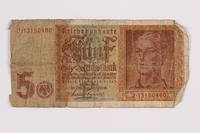
Nazi Germany, 5 mark note, acquired by a war crimes trials court reporter
Object
German bank note valued at 5 marks, issued in 1939, acquired by Dixie Foster when she worked as a civilian court reporter during the US War Crimes Tribunal at the former Dachau concentration camp in Germany, also known as the Dachau war crimes trials. The trials were conducted in the American postwar occupation zone by the US Army from November 1945 to August 1948.
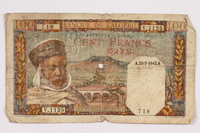
Bank of Algeria, 100 franc note, acquired by a war crimes trials court reporter
Object
French Algerian bank note valued at 100 francs acquired by Dixie Foster when she worked as a civilian court reporter during the US War Crimes Tribunal at the former Dachau concentration camp in Germany, also known as the Dachau war crimes trials. The trials were conducted in the American postwar occupation zone by the US Army from November 1945 to August 1948.
Dixie Foster papers
Document
The papers consist of a scrapbook, a newspaper clipping, and a document (4 pages) collected by Dixie Foster while she served as a secretary during the war crime trials in Europe after World War II.
Camps de mort [Book]
Object
Illustrated history of the death camps in Europe created immediately after the end of World War II in May 1945. It was acquired by Dixie Foster when she worked as a civilian court reporter during the US War Crimes Tribunal at the former Dachau concentration camp in Germany, also known as the Dachau war crimes trials. The trials were conducted in the American postwar occupation zone by the US Army from November 1945 to August 1948.
Pamphlet
Object
Softcover book titled, Illustrated history of the Dora-Nordhausen War Crimes Trial, given to Dixie Foster with a personal inscription by the author. It was acquired by Dixie when she worked as a civilian court reporter during the US War Crimes Tribunal at the former Dachau concentration camp in Germany, also known as the Dachau war crimes trials. The trials were conducted in the American postwar occupation zone by the US Army from November 1945 to August 1948. William J. Aalmans, the author, was a War Department civilian and a member of the Netherlands Army, who was attached to a War Crimes Investigation Team of the First American Army. He edited and complied the book and also witnessed and photographed some of the scenes presented in the book.
Portfolio
Object
Portfolio of rotogravure prints of 24 drawings by George (Jerzy) Zielezinski depicting scenes he witnessed of daily life and death as a prisoner in German concentration camps from 1943-1945. The set includes a portfolio cover, a folded insert with an essay about the prints, and 24 individual reproductions. After his emigration to the US in 1949, sets were sold by the American Friends Service Committee to raise funds for Zielezinski's support. Zielezinski, a Polish Catholic, was arrested in March 1943 in Warsaw by the German occupation authorities for political activity. He was sent to Auschwitz and, in January 1944, to Flossenbürg. In mid-April 1945, as Allied troops approached, the SS began evacuations, sending prisoners to Dachau on trains and via death marches. After liberation on April 29, 1945, Jerzy was hospitalized and while recovering he made finished drawings of camp life and atrocities, based upon the sketches he made secretly on scraps of paper in the camps. He then lived in Schwandorf and Munich displaced persons camp, until gong to America. The portfolio was acquired by Dixie Foster, presumably when she worked as a civilian court reporter during the US War Crimes Tribunal at the former Dachau concentration camp in Germany, also known as the Dachau war crimes trials. The trials were conducted by the US Army in the American postwar occupation zone from November 1945 to August 1948.



